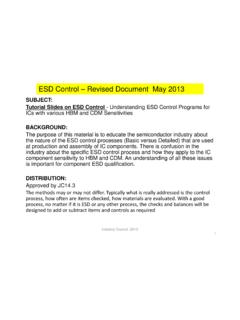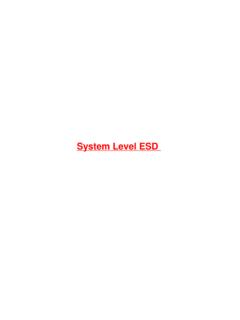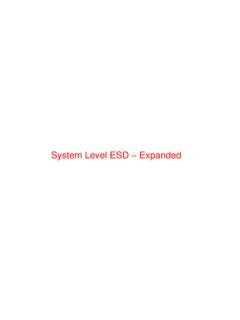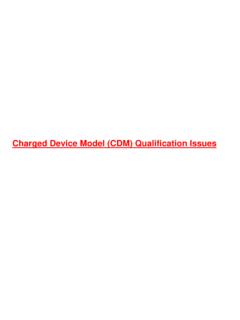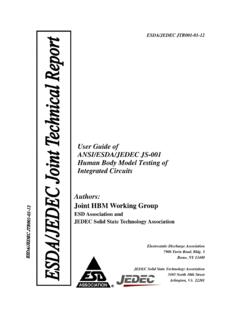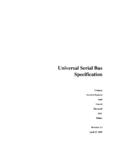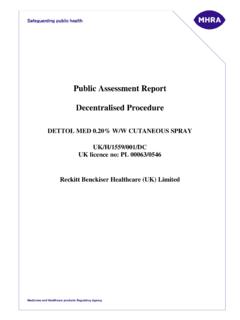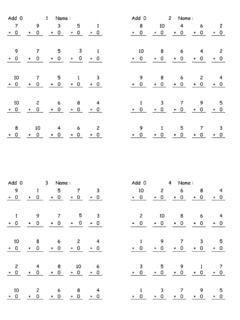Transcription of JEDEC SSD Specifications Explained
1 JEDEC SSD Specifications Explained Alvin Cox, Seagate Chairman, JEDEC SSD Standards JESD218, Solid State Drive (SSD). Requirements and Endurance Test Method JESD219, Solid State Drive (SSD). Endurance Workloads What do these standards include? SSD Requirements SSD Definitions SSD Capacity Application Classes Endurance Rating Endurance Verification SSD Endurance Workloads Client Enterprise Scope of JESD218. Define JEDEC requirements for SSDs, classes of SSDs, and the conditions of use and corresponding endurance verification requirements. The standard is sufficient for the endurance and retention part of SSD. qualification. Developed for SSDs with NAND NVM. Reference Documents JESD22-A117, Electrically Erasable Programmable ROM (EEPROM) Program/Erase Endurance and Data Retention Stress Test JESD47, Stress-Test-Driven Qualification of Integrated Circuits JEP122, Failure Mechanisms and Models for Semiconductor Devices JESD219, Solid State Drive (SSD) Endurance Workloads Key Definitions Endurance failure A failure caused by endurance stressing.
2 Endurance rating (TBW rating). The number of terabytes that may be written to the SSD while still meeting the requirements. Key Definitions Erase block The smallest addressable unit for erase operations, typically consisting of multiple pages. Page A sub-unit of an erase block consisting of a number of bytes which can be read from and written to in single operations, through the loading or unloading of a page buffer and the issuance of a program or read command. Key Definitions Program/erase cycle The writing of data to one or more pages in an erase block and the erasure of that block, in either order. Retention failure A data error occurring when the SSD is read after an extended period of time following the previous write. Key Definitions Solid state drive A solid state drive (SSD) is a non-volatile storage device. A controller is included in the device with one or more solid state memory components. The device should use traditional hard disk drive (HDD) interfaces (protocol and physical) and form factors.
3 Key Definitions Unrecoverable Bit Error Ratio (UBER). A metric for the rate of occurrence of data errors, equal to the number of data errors per bits read. Key Definitions Write amplification factor (WAF). The data written to the NVM divided by data written by the host to the SSD. UBER of HDDs and SSDs Example: 70GB, TBW rating = 70TB. UBER rating # corrupt sectors per drive SSD. HDD. TBW rating 0. 0 200 400 600 800 1000. Drive Rewrites Material submitted by Intel UBER equality question Example: 70GB, TBW rating = 70TB. Does allowing the limit to # corrupt sectors per drive intersect the constant line SSD. result in a much worse UBER at HDD that point in time than the specification limit? 0. 0 200 400 600 800 1000. Drive Rewrites Instantaneous UBER for the spec limit is when dx/dt of SSD UBER = dx/dt of constant UBER =. Specification limit ( , slope of tangent line to curve equals that of a constant UBER over life slope). UBER. Lifetime-average is the standard in reliability (may be more familiar by its equivalent name, cumulative % fail).
4 Instantaneous slope is not used as the basis for qualification. Lifetime average is in the draft because it is the most accurate value to use and the most consistent with prior practice. UBER determination Although the UBER concept is in widespread use in the industry, there is considerable variation in interpretation. In this JESD218, the UBER values for SSDs are lifetime values for the entire population. The numerator is the total count of data errors detected over the full TBW rating for the population of SSDs, or the sample of SSDs in the endurance verification. A sector containing corrupted data is to be counted as one data error, even if it is read multiple times and each time fails to return correct data. The denominator is the number of bits written at the TBW rating limit, which aligns to the usual definition of errors per bit read when the read:write ratio is unity. WAF. Write amplification factor (WAF). The data written to the NVM divided by data written by the host to the SSD.
5 An SSD usually writes more data to the memory than it is asked to write. The nature of the workload plays a significant role. WAF. Factors that impact WAF: Sequential versus random Large transfers versus small ones Boundary alignment Data content/patterns (especially for SSDs using data compression). WAF example Because NAND can only be written to after having been erased, and the granularity of erasure is coarse (referred to as the Erase Block), some NAND management algorithms can result in a large amount of data being written to NAND for a modest amount requested to be written by the host. The multiplication factor that describes how much larger the ultimate write to the NAND. becomes is known as write amplification. For example, if a host write of 4KB results in a write to the NAND of 16KB, then the write amplification is 4. Material submitted by Intel WAF example The figure shows one NAND block comprised of 64 pages. For this example, assume that each page is 2KB in size (four sectors) giving a total of 256 sectors per block.
6 This block has valid host data in all of its pages. Assume that the host writes only some pages in this block with new data as illustrated on the next slide. Material submitted by Intel WAF example In NAND, before programming a page it has to be first erased and the erase granularity in NAND is in blocks. Therefore to program the 8 sectors shown in yellow in Figure 2 above, one possible approach is to use a read/modify/write algorithm as follows: 1. Copy entire block (page 0 to page 63) to DRAM. 2. Modify pages 1, 2 and 3 with the new data that the host wants to write. DRAM now has the block as shown in the figure with the new Host data. 3. Erase the block in the NAND. 4. Program the block with the data from DRAM. (This is equivalent to writing 256 sectors in the NAND.). With this implementation, a host write of 8 sectors resulted in a NAND write of 256 sectors. The write amplification for this example is 32 (256/8). Material submitted by Intel WAF example Note that had the example above used a larger transfer that spanned the entire erase block (or sequential transfers that could be internally buffered in the SSD to fill the entire erase block).
7 That the write amplification would essentially be 1 since the entire erase block would have new data to be written. The nature of the workload has substantial impact on resulting write amplification and in general small random writes tend to create the largest write amplification values. Material submitted by Intel SSD capacity SSD Capacity in Gbytes = (User- addressable LBA count - 21168) /. 1953504. Same value as IDEMA for HDDs except no 50GB limit Requested by OEMs for ease of implementation (HDD or SSD). This version for 512 byte sectors 4k sector version in development Application classes Current application classes: Client Enterprise Application classes attributes: Workload Data retention BER. Endurance rating Establish a rating system for comparing SSDs. Provides unique rating for application class. Rating based on a user-measurable interface activity: TBW. TBW = TeraBytes Written. Decimal value to be consistent with user interfaces.
8 Endurance rating The SSD manufacturer shall establish an endurance rating for an SSD that represents the maximum number of terabytes that may be written by a host to the SSD, using the workload specified for the application class, such that the following conditions are satisfied: 1) the SSD maintains its capacity;. 2) the SSD maintains the required UBER for its application class;. 3) the SSD meets the required functional failure requirement (FFR). for its application class; and 4) the SSD retains data with power off for the required time for its application class. This rating is referred to as TBW. Requirements for UBER, FFR, and retention are defined for each application class. SSD endurance classes and requirements Application Workload Active Use Retention Functional UBER. Class (power on) Use Failure (power off) Rqmt (FFR). Client Client 40oC 30oC 3% 10-15. 8 hrs/day 1 year Enterprise Enterprise 55oC 40oC 3% 10-16. 24hrs/day 3 months Temperatures and data retention Tables show # weeks retention as a function of active and power-off temperatures.
9 Numbers are based on Intel s published acceleration model for the detrapping retention mechanism (the official JEDEC model in JESD47 and JEP122 for this mechanism). Material submitted by Intel Endurance rating example Using the appropriate workload, the SSD manufacturer may determine the relationship between host writes and NAND. cycles, the latter being the number of p/e cycles applied to any NAND block, and use this relationship to estimate the SSD endurance rating. If the SSD employs more than one type of NAND component with different cycling capabilities, then a separate relationship should be obtained for each type of NAND. If operating the SSD to the desired TBW is impractical because time required would be excessive, then the relationship between NAND cycles and host writes should be extrapolated. In performing the extrapolation, any nonlinearities in SSD operation, such as those resulting from a reduced cycling pool at extended cycles, should be accounted for.
10 Endurance rating example The estimated endurance rating is the TBW such that f(TBW) < NAND cycling capability (1). where f(TBW) expresses maximum NAND cycles as a function of TBW. The relationship may be different for different types of NAND components used in the SSD. Consider an SSD containing only one type of NAND and no features of the drive design that would make the WAF change over the lifetime of the drive. Suppose further that the design of the wear leveling method is expected to result in the most heavily-cycled erase block receiving twice the average number of cycles. Endurance rating example In that case, WAF would be a constant (for a given workload), and f(TBW) = (TBW 2 WAF) / C. where C is the SSD capacity and the factor of two is the guard band for the wear leveling effects. The SSD endurance rating would then become TBW < (C NAND cycling capability) / (2 WAF). In the more general case, WAF may not be a constant. More extensive characterization would be needed to determine f(TBW) in equation (1) before estimating the endurance rating.
